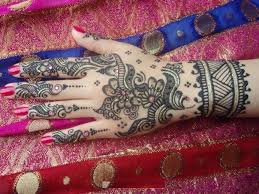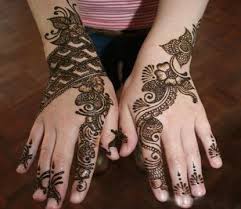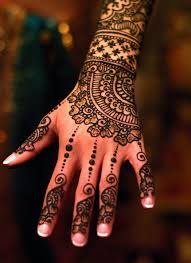source(google.com.pk)
Traditional Henna Design Biography
The different words for henna in ancient languages imply that it had more than one point of discovery and origin, as well as different pathways of daily and ceremonial use.Traditional Henna Designs has been used to adorn young women's bodies as part of social and holiday celebrations since the late Bronze Age in the eastern Mediterranean. The earliest text mentioning henna in the context of marriage and fertility celebrations comes from the Ugaritic legend of Baal and Anath,[15] which has references to women marking themselves with henna in preparation to meet their husbands, and Anath adorning herself with henna to celebrate a victory over the enemies of Baal.
Wall paintings excavated at Akrotiri (dating prior to the eruption of Thera in 1680 BCE) show women with markings consistent with henna on their nails, palms and soles, in a tableau consistent with the henna bridal description from Ugarit.[16] Many statuettes of young women dating between 1500 and 500 BCE along the Mediterranean coastline have raised hands with markings consistent with henna. This early connection between young, fertile women and henna seems to be the origin of the Night of the Henna, which is now celebrated worldwide.The Night of the Henna was celebrated by most groups in the areas where henna grew naturally: Jews,[17] Muslims,[18] Hindus, Christians and Zoroastrians, among others, all celebrated marriages by adorning the bride, and often the groom, with henna.
An intricate Mehandi pattern
Across the henna-growing region, Purim,[17] Eid,[19] Diwali,[20] Karva Chauth, Passover, Nowruz, Mawlid, and most saints' days were celebrated with some henna. Favorite horses, donkeys, and salukis had their hooves, paws, and tails hennaed. Battle victories, births, circumcision, birthdays, Zār, as well as weddings, usually included some henna as part of the celebration. When there was joy, there was henna, as long as henna was availableTraditional Henna Designa was regarded as having "Barakah," blessings, and was applied for luck as well as joy and beauty.[21] Brides typically had the most henna, and the most complex patterns, to support their greatest joy, and wishes for luck. Some bridal traditions were very complex, such as those in Yemen, where the Jewish bridal henna process took four or five days to complete, with multiple applications and resist work.
The fashion of "Bridal Mehndi" in Pakistan, Northern Libya and in North Indian diasporas is currently growing in complexity and elaboration, with new innovations in glitter, gilding, and fine-line work. Recent technological innovations in grinding, sifting, temperature control, and packaging henna, as well as government encouragement for henna cultivation, have improved dye content and artistic potential for henna.
Though traditional henna artists were Nai caste in India, and barbering castes in other countries (lower social classes), talented contemporary henna artists can command high fees for their work. Women in countries where women are discouraged from working outside the home can find socially acceptable, lucrative work doing henna. Morocco, Mauritania,[22] Yemen, Libya, Somalia, Sudan, as well as India and many other countries have thriving women's henna businesses. These businesses are often open all night for Eids, Diwali and Karva Chauth, and many women may work as a team for a large wedding where hundreds of guests will be hennaed as well as the bride and groom.
Henna is known to be dangerous to people with glucose-6-phosphate dehydrogenase deficiency (G6PD deficiency), which is more common in males than females. Infants and children of particular ethnic groups are especially vulnerable.[23] Though user accounts cite few other negative effects of natural henna paste, save for occasional allergic reactions, pre-mixed henna body art pastes may have ingredients added to darken stain, or to alter stain color. The health risks involved in pre-mixed paste can be significant. The United States Food and Drug Administration (FDA) does consider these risks to be adulterants and therefore illegal for use on skin.[24] Some pastes have been noted to include: silver nitrate, carmine, pyrogallol, disperse orange dye, and chromium.[25] These have been found to cause allergic reactions, chronic inflammatory reactions, or late-onset allergic reactions to hairdressing products and textile dyes.[26][27]












Traditional Henna Design Biography
The different words for henna in ancient languages imply that it had more than one point of discovery and origin, as well as different pathways of daily and ceremonial use.Traditional Henna Designs has been used to adorn young women's bodies as part of social and holiday celebrations since the late Bronze Age in the eastern Mediterranean. The earliest text mentioning henna in the context of marriage and fertility celebrations comes from the Ugaritic legend of Baal and Anath,[15] which has references to women marking themselves with henna in preparation to meet their husbands, and Anath adorning herself with henna to celebrate a victory over the enemies of Baal.
Wall paintings excavated at Akrotiri (dating prior to the eruption of Thera in 1680 BCE) show women with markings consistent with henna on their nails, palms and soles, in a tableau consistent with the henna bridal description from Ugarit.[16] Many statuettes of young women dating between 1500 and 500 BCE along the Mediterranean coastline have raised hands with markings consistent with henna. This early connection between young, fertile women and henna seems to be the origin of the Night of the Henna, which is now celebrated worldwide.The Night of the Henna was celebrated by most groups in the areas where henna grew naturally: Jews,[17] Muslims,[18] Hindus, Christians and Zoroastrians, among others, all celebrated marriages by adorning the bride, and often the groom, with henna.
An intricate Mehandi pattern
Across the henna-growing region, Purim,[17] Eid,[19] Diwali,[20] Karva Chauth, Passover, Nowruz, Mawlid, and most saints' days were celebrated with some henna. Favorite horses, donkeys, and salukis had their hooves, paws, and tails hennaed. Battle victories, births, circumcision, birthdays, Zār, as well as weddings, usually included some henna as part of the celebration. When there was joy, there was henna, as long as henna was availableTraditional Henna Designa was regarded as having "Barakah," blessings, and was applied for luck as well as joy and beauty.[21] Brides typically had the most henna, and the most complex patterns, to support their greatest joy, and wishes for luck. Some bridal traditions were very complex, such as those in Yemen, where the Jewish bridal henna process took four or five days to complete, with multiple applications and resist work.
The fashion of "Bridal Mehndi" in Pakistan, Northern Libya and in North Indian diasporas is currently growing in complexity and elaboration, with new innovations in glitter, gilding, and fine-line work. Recent technological innovations in grinding, sifting, temperature control, and packaging henna, as well as government encouragement for henna cultivation, have improved dye content and artistic potential for henna.
Though traditional henna artists were Nai caste in India, and barbering castes in other countries (lower social classes), talented contemporary henna artists can command high fees for their work. Women in countries where women are discouraged from working outside the home can find socially acceptable, lucrative work doing henna. Morocco, Mauritania,[22] Yemen, Libya, Somalia, Sudan, as well as India and many other countries have thriving women's henna businesses. These businesses are often open all night for Eids, Diwali and Karva Chauth, and many women may work as a team for a large wedding where hundreds of guests will be hennaed as well as the bride and groom.
Henna is known to be dangerous to people with glucose-6-phosphate dehydrogenase deficiency (G6PD deficiency), which is more common in males than females. Infants and children of particular ethnic groups are especially vulnerable.[23] Though user accounts cite few other negative effects of natural henna paste, save for occasional allergic reactions, pre-mixed henna body art pastes may have ingredients added to darken stain, or to alter stain color. The health risks involved in pre-mixed paste can be significant. The United States Food and Drug Administration (FDA) does consider these risks to be adulterants and therefore illegal for use on skin.[24] Some pastes have been noted to include: silver nitrate, carmine, pyrogallol, disperse orange dye, and chromium.[25] These have been found to cause allergic reactions, chronic inflammatory reactions, or late-onset allergic reactions to hairdressing products and textile dyes.[26][27]
Traditional Henna Design
Traditional Henna Design
Traditional Henna Design
Traditional Henna Design

Traditional Henna Design
Traditional Henna Design
Traditional Henna Design
Traditional Henna Design
Traditional Henna Design
Traditional Henna Design
Traditional Henna Design
Traditional Henna Design
Traditional Henna Design
Circular/Round Traditional Indian/Pakistani Henna Mehendi Design
Henna Designs 2011
Traditional Circular/Round Henna Mehendi Design
No comments:
Post a Comment